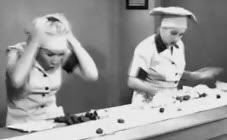When employment professionals in California meet today, as at the recent California Workforce Association gathering in Monterey, a central issue is the following: To what extent is the job losses brought by the Great Recession cyclical, representing the ups and downs of the business cycle? To what extent do these job losses represent structural change in a California economy that will need fewer workers?
We won’t know the answer to this for some time. However, some perspective on this discussion can be gained from going back nearly 50 years in California when we had a similar discussion in state government about technology. In the mid-1960s, California state government was up in arms about the march of automation, and the job losses following automation.
 California during the 1950s and early 1960s had built a middle class based in good part on the manufacturing boom in aerospace, defense and automobiles. These jobs paid middle class wages and offered steady employment.
California during the 1950s and early 1960s had built a middle class based in good part on the manufacturing boom in aerospace, defense and automobiles. These jobs paid middle class wages and offered steady employment.
Automation threatened to eliminate these jobs, as machines replaced workers. Further, automation threatened to satiate consumer desires for televisions, refrigerators, household appliances, and automobiles. Employers would be faced with few consumer goods to produce.
The automation scare was not limited to California. In 1965, the soon-to-be influential public policy journal The Public Interest, focused its first issue on "The Great Automation Question", with prominent economists Robert Solow and Robert Heilbroner addressing whether America was facing permanent shortages of jobs. Professor Heilbroner foresaw permanent high unemployment, and the need for public sector jobs and an array of welfare state policies. The following year amid widespread attention and a Congressional hearing, the National Commission on Technology, Automation and Economic Progress issued its report on technology and job elimination. The Commission was less alarmist than Professor Heilbroner, but still saw a need for public sector employment and federal government health and welfare supports.
Of course, what transpired was that automation did eliminate jobs in California and elsewhere. But other products and services emerged. Nearly every household in America with electricity had a television set and refrigerator by 1966. However, consumer demand developed for color televisions, car phones, video games, electric garage openers, and other goods not widely available in 1966. Consumers also decided they needed newer cars, and newer clothes, and newer household appliances.
In California, manufacturing payroll jobs totaled 1,428,000 in January 1966. By January 1976, that number had not declined, but rather had increased to 1,590,700 jobs, and reached 2.1 million manufacturing jobs in August 1989. Since that time, manufacturing employment has declined, but still stood at 1,459,300 payroll jobs in August 2007, just prior to the Great Recession.
Technology, along with globalization, will continue to eliminate jobs in California, that will not return after the Recession. To what extent technology and globalization will greater even a greater number of jobs remains to be determined. We can only hope that the past of California automation is prologue.

